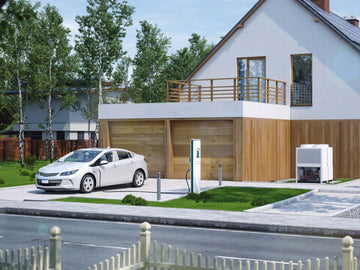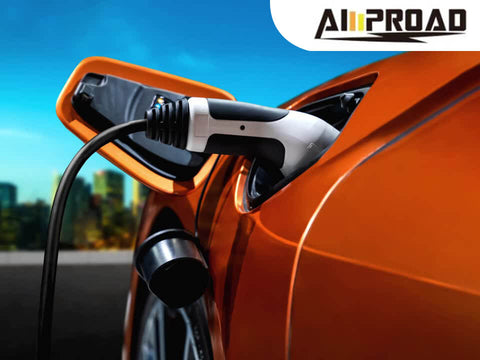What Will Happen to Tesla Destination Charger Stations Once NACS Ports Become the Norm?
May 08, 2024

The rise of the NACS charging standard has EV drivers wondering: what happens to Tesla's Destination Chargers? These convenient stations have fueled Tesla's success, but will they become obsolete with the wider adoption of NACS ports? This article explores the evolving landscape of EV charging infrastructure. We'll delve into the benefits of NACS standardization, the potential fate of Tesla Chargers, and the impact on driver experience. Buckle up as we navigate the future of charging for electric vehicles!
The Rise and Role of Tesla Destination Chargers
Tesla's Destination Charger network has been a key player in the electric vehicle (EV) revolution. These convenient charging stations, often located at hotels, restaurants, and shopping centers, have offered a seamless charging experience for Tesla owners. But with the emergence of the NACS (North American Charging Standard) port, questions arise about the future of Tesla's Destination Chargers. Let's take a closer look at their past and potential impact.
How have Destination Chargers fueled Tesla's strategy?
Tesla's Destination Chargers have played a critical role in their success by providing several advantages:
- Strategic Network: By strategically placing chargers at popular destinations, Tesla encouraged long-distance travel for their vehicles and alleviated "range anxiety" for drivers concerned about running out of battery power.
- Brand Loyalty: The ease and convenience of Tesla Destination Chargers helped build brand loyalty among Tesla owners, solidifying their position as a leader in the EV market.
Positive Ownership Experience: Easy access to charging during errands or road trips contributed to a positive overall ownership experience for Tesla drivers.
Are Destination Chargers a barrier for non-Tesla EV adoption?
While Tesla's Destination Chargers benefit their own customers, they can be a hurdle for non-Tesla EV ownership:
- Proprietary System: Tesla's use of a unique connector limits charging options for owners of other electric vehicle brands. This can be a significant drawback for potential EV buyers considering charging infrastructure.
- Slower Growth of Overall EV Market: Limited access to Destination Chargers for non-Tesla EVs might have slowed down the overall growth of the EV market by discouraging broader adoption.
- Highlighting the Need for Standardization: The limitations of Tesla's proprietary system have underscored the need for a universal charging standard like NACS, allowing all EVs to utilize the same charging infrastructure.
The convenience and strategic placement of Tesla's Destination Chargers have undoubtedly been a boon for Tesla. However, their exclusivity has also highlighted the need for a more inclusive charging network, paving the way for the NACS standard. In the next section, we'll explore the potential benefits of NACS adoption and how it might impact the future of EV charging infrastructure.
NACS Enters the Arena: A Universal Charging Solution?

Tesla Destination Charger network has been a key player in the electric vehicle (EV) revolution. These convenient charging stations, often located at hotels, restaurants, and shopping centers, have offered a seamless charging experience for Tesla owners. But with the emergence of the NACS (North American Charging Standard) port, questions arise about the future of Tesla's Destination Chargers. Let's take a closer look at their past and potential impact.
Convenience for Tesla Owners: How have Destination Chargers fueled Tesla's strategy?
The widespread adoption of NACS ports has the potential to revolutionize the EV charging landscape by offering several key benefits:
- Convenience and Flexibility for All Drivers: With NACS ports becoming the norm, EV drivers of any brand will have access to a wider network of charging stations. This eliminates the need to search for specific compatible chargers, fostering greater convenience and flexibility for road trips and everyday errands.
- Boosting EV Adoption: A standardized charging system can significantly reduce range anxiety for potential EV buyers. Knowing they can easily find compatible charging stations throughout their travels can make electric vehicles a more attractive option, potentially accelerating the overall adoption of EVs.
- Streamlined Infrastructure Development: NACS standardization simplifies the process of building and deploying new charging stations. This can encourage greater investment in charging infrastructure, leading to a denser network of readily available charging options for all EV drivers.
- Reduced Costs for Consumers and Businesses: Standardization can potentially lead to economies of scale in manufacturing NACS charger, resulting in lower costs for both consumers and businesses. This can make EV ownership more accessible and incentivize businesses to invest in charging stations at their locations.
- Future-Proof Design: The NACS standard is designed to accommodate the evolving needs of EVs. It can handle a wider range of charging speeds and battery capacities, ensuring compatibility with future generations of electric vehicles.
However, the question remains: can NACS ports truly future-proof the EV charging infrastructure?
Future-Proof Technology? Can NACS Ports Accommodate the Evolving Needs of EVs?
While NACS offers a significant leap forward, technological advancements in EVs might necessitate further innovation in charging infrastructure:
- Faster Charging Technologies: As battery technology improves, the demand for even faster charging speeds might arise. NACS may need to adapt or integrate with future technologies to accommodate ultra-fast charging capabilities.
- Wireless Charging Integration: The potential for wireless charging could become a reality in the future. NACS compatibility might need to evolve to incorporate wireless charging solutions seamlessly.
- Standardization Across Continents: Currently, NACS is a North American standard. For a truly universal charging experience, future iterations might need to consider global compatibility with charging standards in other regions.
The NACS standard represents a significant step towards a more unified and accessible EV charging infrastructure. While it offers numerous benefits for both drivers and businesses, future advancements in battery and charging technology might necessitate further adaptation and innovation in the years to come.
In the next section, we'll delve into the potential fate of Tesla's Destination Chargers in the face of NACS adoption. We'll explore the possibilities of coexistence, conversion, or a complete phase-out.
The Fate of Tesla Chargers: Coexistence or Conversion?
Tesla's Supercharger network has been a major advantage for Tesla car owners, offering fast and convenient charging on long trips. But with the rise of the NACS charging standard, many wonder what the future holds for Tesla's charging infrastructure. There are two main questions to consider:
Can Tesla Stations adapt to NACS compatibility?
The answer is yes! Tesla is opening its Supercharger network to other automakers using the NACS standard. This means that in the coming years, some Tesla stations will be equipped to handle both Tesla and NACS-compatible vehicles. Initially, drivers of NACS-compatible cars might need an adapter provided by their automaker to use a Tesla Supercharger. Eventually, new NACS-equipped cars won't even need adapters, as they'll have the NACS plug built right in.
Will Tesla Chargers become obsolete with NACS dominance?
Not necessarily. Tesla station offers a high-powered charging experience (similar to DC fast charger) compared to the slower Level 2 EV charger typically found at home or public stations. This makes Tesla Superchargers ideal for long trips where you need to quickly add a significant amount of range. So, while NACS will likely become the standard for public charging, Tesla Superchargers are likely to coexist and cater to drivers needing a faster top-up.
Overall, the future of Tesla Chargers seems to be one of adaptation and coexistence with NACS. This will ultimately benefit all EV drivers by providing more options for convenient charging on the go.
Impact on EV Drivers
NACS charging standards are poised to significantly improve the experience for EV drivers on road trips. Here's how:
Will NACS ports offer greater flexibility for EV road trips?
Yes, NACS compatibility will significantly improve flexibility for EV road trips. Here's why:
- Wider network of charging stations: With NACS becoming the standard, EV drivers will have access to a much larger network of charging stations compared to relying solely on brand-specific chargers like Tesla Superchargers. This means more options for finding a station when you need it, reducing range anxiety on long trips.
- Reduced reliance on adapters: Currently, drivers of non-Tesla EVs might need adapters to use some public chargers. NACS eliminates this need, simplifying the charging experience. No more fumbling with multiple connectors or worrying about compatibility.
- Increased competition: A wider network of charging stations, fueled by NACS compatibility, can lead to increased competition among providers. This can potentially benefit drivers with lower charging costs and improved service, as providers vie for your business.
Who shoulders the cost of NACS station implementation?
The cost of implementing NACS stations will likely be shared by several parties:
|
Party |
Contribution |
|
Governments |
Grants, subsidies, or tax breaks for businesses that install NACS chargers. |
|
Charging station operators |
Upgrade existing infrastructure to support NACS. |
|
Automakers |
Work with charging station operators or invest in their own NACS-compliant charging networks. |
Governments are recognizing the importance of EV infrastructure and are offering incentives to encourage the adoption of NACS charging stations. This can help offset the upfront costs for businesses that install NACS chargers. Charging station operators will likely need to invest in upgrading their existing infrastructure to support NACS, but the long-term benefits of a wider customer base and increased usage could outweigh the initial costs. Automakers might also contribute to the cost of NACS implementation by working with charging station operators or investing in their own charging networks that comply with the NACS standard. By sharing the burden of implementation, all stakeholders can help accelerate the transition to a more electric transportation future.
The Future of EV Charging Infrastructure

The landscape of EV charging infrastructure is rapidly evolving, but NACS isn't the only story. Let's explore what the future might hold:
Are there potential future charging technologies on the horizon?
Yes, innovation in EV charging technology is ongoing. Here are some exciting possibilities:
- Ultra-fast charging: Imagine topping up your EV in minutes, similar to filling a gas tank. While NACS offers faster charging than Level 2 EV chargers, research on even faster "ultra-fast" charging technologies is underway. These could significantly reduce charging times, further diminishing range anxiety for EV drivers.
- Wireless charging: Imagine parking your car and it automatically starts charging without needing to plug anything in. Wireless charging for EVs is still in its early stages, but it holds promise for a future of seamless and convenient charging, especially at home or in parking lots.
- Grid integration: As the number of EVs on the road increases, managing the strain on the electricity grid becomes crucial. Smarter charging technologies that integrate with the grid are being developed. These EVCS (Electric Vehicle Charging Stations) could automatically adjust charging rates based on grid demand, helping to ensure a stable and efficient power supply.
How can stakeholders work together to ensure an efficient charging network?
Building a robust and efficient EV charging network requires collaboration between various stakeholders:
- Governments: By offering incentives for EV purchases and EVCS installation, governments can accelerate the transition to electric vehicles.
- Utilities: Upgrading the power grid to handle the increased demand from EVs is essential. Utilities will need to invest in infrastructure and work with charging station operators to ensure efficient power distribution.
- Charging station operators: Standardization on NACS and investment in future technologies like ultra-fast charging and wireless charging will be crucial. Additionally, collaboration with automakers and grid operators can ensure seamless integration of EVs into the power grid.
- Automakers: Developing EVs with longer ranges and faster charging capabilities will improve the overall EV experience. Additionally, automakers can contribute to the cost of NACS implementation and explore innovative charging solutions in collaboration with charging station operators.
By working together, all stakeholders can create a future where EV charging is convenient, efficient, and accessible to all, paving the way for a more sustainable transportation system.
Related articles:
Is fast charging bad for battery?




